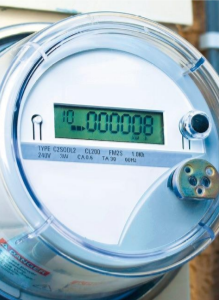Smart Meters

For many years, electric meters have been the sole responsibility of electric utilities. Building owners are now installing their own electric meters to determine the power produced by on-site renewable energy sources, such as solar or wind. Green construction codes require a means for measuring, monitoring and reporting on energy use, production and reclamation in a building, which is accomplished by smart meters.
The idea behind smart meters is simple: Let technology help conserve energy and lower energy costs. Smart meters represent a new way of managing power, one that enables two-way data and energy exchange. With smart meters, devices can be set to power on when demand for power is low. For consumers, smart meters mean more control over how energy is used, allowing them to take advantage of off-peak decreased utility rate structures. For utilities, smart meters allow for remote reading, monitoring of load control and other important functions.
Smart meters utilize new construction materials and electronic components that need to be evaluated to address safety concerns. Because smart meters are not provided by nor determined as acceptable by an electric utility, code authorities are left to determine compliance of these meters with energy and electric code requirements. Fortunately, certifications are available to help them achieve safe, code compliant installations.
Type A and Type S meters
Smart meters are either detachable (Type S) or nondetachable (Type A). Their primary function is to monitor energy consumption for revenue metering. Plug-in type meters are intended for installation in meter sockets, meter-socket bases, metering transformer cabinets or other equipment (such as panelboards and switchboards) incorporating provisions for plug-in type meters.
The UL certification product categories for these types of equipment are Meter Sockets ( PJYZ), Meter-socket Bases (PJWT), Metering Transformer Cabinets (PJXS) and Meter Fittings (PJVV). These meters may or may not be under the control of an electric utility and are certified by UL under the Electric Utility Meters product category (POCZ). The ratings of these meters are limited to 600 V ac maximum, with a maximum of 400 A through any one meter and they are intended for installation in ordinary locations.
Smart meters may communicate with other devices via power-line carrier, satellite/radio frequency, telephone, cable or other communication means that may be one- or two-way. One-way communication is typically used for data collection and/or reporting, including automated meter reading (AMR). Two-way communication is typically part of an advanced
metering infrastructure (AMI), that may include signaling other equipment in the infrastructure to take some action in response to electrical demand. Certifications do not cover any portion of the AMI other than the meter.
Testing and evaluation requirements.
Traditional meters used by utilities are only evaluated to the NEMA C12 series of standards, which are performance standards used to determine meter accuracy and reliability. The introduction of smart meters raises new concerns about functional safety, performance and product safety data security, and interoperability, which are not fully addressed by the C12 standards.
In order to provide the additional safety requirements necessary for certifying electric utility meters that measure, monitor, record, transmit or receive electrical energy generation or consumption information UL published the UL 2735, Standard for Safety for Electric Utility Meters. This standard was developed to address problems that have been reported from field installations of smart meters, including fires, meters ejecting from meter socket bases and exposed live parts. When electronic components are overstressed, there is a potential for the components to explode. Among other things, UL 2735 addresses the potential flammability of plastic enclosure materials under fault conditions. Meter enclosures are evaluated for the intended environment, and for their ability to completely enclose all live parts and resist impact. Meters intended for connection to current transformers that are not provided with the meter are marked to indicate the ratings of the current transformers to be used with the meter.
For meters utilizing batteries, the batteries are evaluated to determine that they will not cause an explosion or produce a risk of fire as a result of either excessive charge or discharge, or if a battery is installed with incorrect polarity. Meters are tested to single fault conditions in which the discrete components, such as capacitors, diodes and resistors are shorted and opened, and transformers are subjected to short circuit tests. No exposure of live parts and no molten metal, burning insulation or flaming particles are permitted.
Testing includes temperature, insulation resistance, effect of high voltage line surges, effect of temporary overloads, effect of electrical fast transient bursts, effect of radio frequency interference, effect of electrostatic discharge, and weather simulation. Meters are also subjected to static loading, impact, and drop tests.
Energy usage monitoring systems
Meters and other equipment for metering of electricity that are not plugged into a traditional meter socket are certified by UL under the Energy Usage Monitoring Systems product category (FTRZ) in accordance with UL 916, the Standard for Safety for Energy Management Equipment. This category covers products intended for use in metering of utility and non-utility electric power. The primary function of these devices is to monitor power consumption on a building main supply or separate branch circuits. These devices may communicate with other devices by means of power line carrier, satellite/radio frequency, telephone, cable or other means.
Content reprinted from UL’s The Code Authority© newsletter, Issue 3, 2013 and may not reflect changes that have occurred since its original publication.